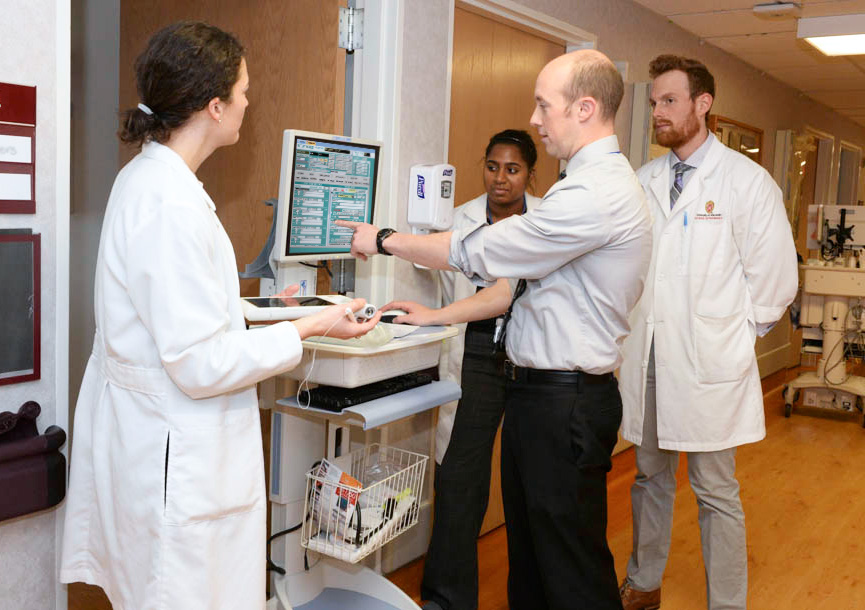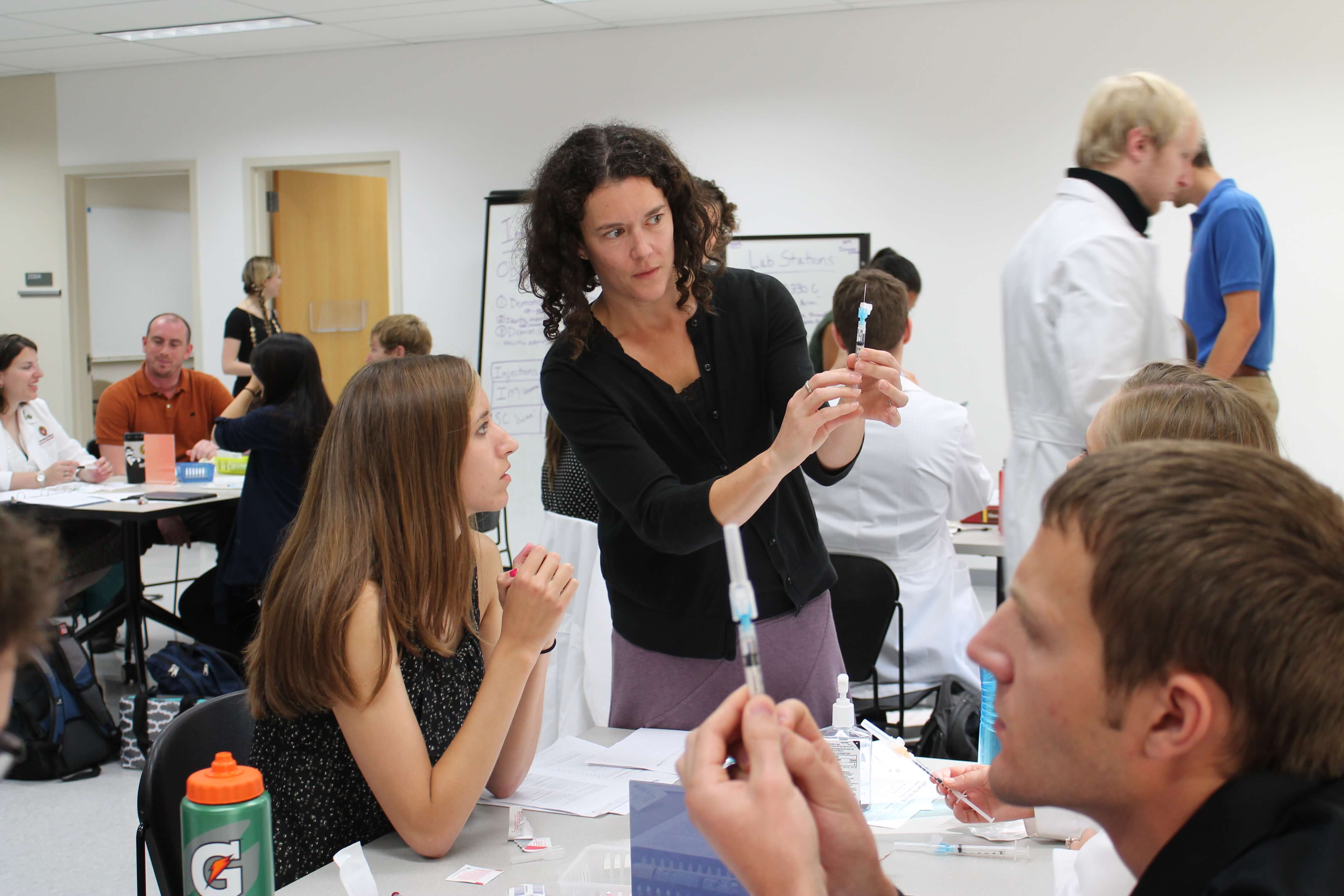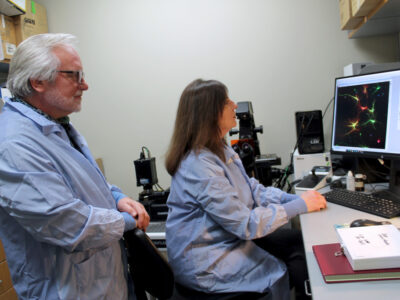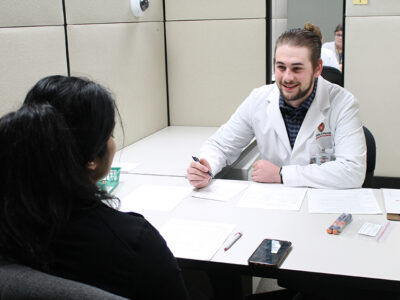
1
March

Susanne Barnett leads prescribing interventions for patients leaving the hospital
By Andrea Mongler
Associate Professor Susanne Barnett (PharmD ’04) in the Pharmacy Practice Division of the University of Wisconsin–Madison School of Pharmacy is passionate about appropriate use of antibiotics.
She says that historically, antimicrobial stewardship efforts have focused on antibiotics prescribed to patients during hospitalization. So when the antimicrobial stewardship team at the William S. Middleton Memorial Veterans Hospital (VA), of which Barnett is a member, saw an opportunity to study antibiotic prescriptions in outpatients, they got to work.
Specifically, Barnett and her colleagues led a study that focused on antibiotic prescribing when patients are discharged from the hospital — known as a transition of care.
“Our hope was that we could positively impact outpatient prescribing through interacting and following up with patients and providers on the prescriptions,” says Barnett, a pharmacist who is board certified in pharmacotherapy.
From June 2017 to December 2018, Barnett or her colleague, Paul Lata (PharmD ’01), another pharmacist, along with a physician — either an infectious disease fellow or the Antimicrobial Stewardship Physician Champion, Prakash Balasubramanian — reviewed every prescription for oral antibiotics written for patients discharged from the VA hospital. They did these reviews, called rounds, each Tuesday and Thursday.

During their rounds, Barnett and colleagues evaluated all prescriptions written since their last review. They checked to see whether:
- The patient needed an antibiotic at all.
- The most appropriate antibiotic had been prescribed.
- The antibiotic was prescribed for the appropriate duration.
When antibiotic prescriptions are administered inappropriately, the risk of the development of antibiotic resistance increases. Antibiotic-resistant bacteria have increased in recent years and are considered a global public health threat.
“Antibiotics can be lifesaving,” Barnett says. “We just have to make sure we are using them in an appropriate way so that we are balancing the risk and the benefit the best we can.”
Whenever Barnett and colleagues identified an antibiotic prescription that could have been improved, they did what they called an intervention. Most of the interventions were considered “educational” because by the time Barnett and her team reviewed the prescription and identified the issue, the patient had finished or nearly finished their antibiotic course — too late to make a change.
In these cases, the research team would put an educational note in the patient’s electronic health record (EHR) that described the intervention. The prescriber and the attending physician were required to sign the note to acknowledge that they’d read it.
“Our study was able to identify that there is a need for antimicrobial stewardship during patient transitions of care. This is a huge opportunity to improve prescribing.” —Susanne Barnett
For patients discharged on the days that Barnett and colleagues did their rounds, though, the team was sometimes able to identify a potentially problematic prescription at the time the patient was being discharged. In these cases, they were able to intervene in real time. This involved contacting the prescriber to recommend a change to the prescription — for example, discontinuing the antibiotic or changing the drug, dose, or duration.
Overall, they reviewed the prescriptions of 929 patients discharged from the hospital and made interventions — both educational and real-time — in 9.7 percent of them. The most common reasons for these interventions were:
- No antibiotic was indicated (43 percent).
- The duration of therapy could have been optimized (24 percent).
- The antibiotic choice could have been optimized (23 percent).
Of the 38 real-time interventions, 58 percent were accepted by providers.

Barnett notes that their study was unique because previously published evaluations of prescriptions originating at the time of discharge have been retrospective — with researchers reviewing prescriptions from months ago, for example — but this one was prospective. The fact educational interventions were made real-time to prescribers during the study period could be why Barnett and colleagues saw the rate of interventions go down over the course of the study and why they had a lower rate of interventions than that recorded in other studies.
“Because we were making interventions and providing immediate feedback to prescribers over the entire study, prescribers had a chance to modify their prescribing,” Barnett says.
The VA was an especially good setting to study transition of care prescribing because it’s a closed system. In other words, veterans not only get care as inpatients there but also get their prescriptions filled from a VA facility once they’re discharged. That’s far different from the experience of patients at non-VA hospitals, who may fill their prescriptions at any number of pharmacies once they’re discharged.
“When a pharmacy gets an electronic prescription for an antibiotic, it’s possible the pharmacist filling the prescription may never have spoken to or seen the prescriber who wrote it,” Barnett says. “But because the VA is a closed system, with electronic health records accessible for inpatients and outpatients, we were able to monitor and impact prescribing on the outpatient side.”
For the next step in their research, Barnett and her colleagues hope to have the opportunity to do interventions more frequently than twice a week. This would allow them to make more interventions in real time, intervening at the patient level.
“Our study was able to identify that there is a need for antimicrobial stewardship during patient transitions of care,” Barnett says. “The way this study can be applied to other institutions that aren’t a closed system like the VA is to do interventions on prescriptions prior to discharge, in real time. If pharmacists were able to implement this service from, say, 10 a.m. to 7 p.m. on weekdays, they would be able to intervene with the prescriber at the time of discharge for the large majority of patients being discharged. This is a huge opportunity to improve prescribing.”







